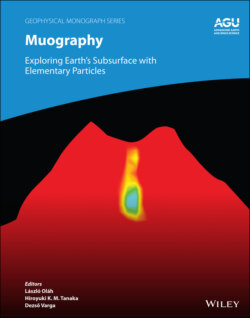Читать книгу Muography - Группа авторов - Страница 22
1.2.7 Background Events in Muography
ОглавлениеThe background events that degrade the quality of muographic images can be originated from both outside (extrinsic background) and inside (intrinsic background) the observation system (a combination of detectors, radiation shields, and other related equipments). Primary GCRs produce not only muons but also cascades of protons, neutrons, mesons, and other electromagnetic particles. The extrinsic background is generated by these secondary particles. The number of these particles rapidly decreases as they travel in the atmosphere but some of them arrive at sea level. The number of protons, electrons, and pions above 1 GeV are, respectively, two orders, three orders, and four orders of magnitude lower than the number of muons in the same energy range at sea level (Particle Data Group, 2020). However, when kilometric objects are observed in which low muon rates are expected, these backgrounds substantially degrade the image contrast. In particular, the protons are heavier than muons; hence longer MFP is present within the material (~10 cm in Pb), and thus could be a serious source of the background. On the contrary, the electromagnetic components such as electrons and gammas can be rejected relatively simply by requesting a linear trajectory through multiple layers of detectors and radiation shields. The radiation length of electrons is less than 6 mm in Pb.
The intrinsic background is caused by the muons scattered inside the observation system. Increasing the thickness of the radiation shields to reduce more extrinsic background rates would result in more muons being scattered inside the detectors, and thus the resultant images would be blurred. The intrinsic background level can be reduced by improving the tracking quality of the observation system (Kusagaya, 2017).
In an extraterrestrial environment, the condition of the extrinsic background will be completely different from the terrestrial one. Unlike Earth, Mars and small solar system bodies (SSSB) either do not have their own atmosphere or, they have an extremely thin atmosphere. Therefore, GCRs and GCR‐originated gamma rays (continuum gamma rays) will tend to directly hit the ground surface. As a result, the level of the extrinsic background is much higher than that on the Earth’s surface, for example, the proton flux at the ground level of these SSSBs tends to be 100 times higher than the terrestrial muon flux of Earth at sea level (Prettyman et al., 2014). However, in outer space, it is difficult to reject these high‐rate extrinsic backgrounds by using radiation shields, since these shields would add too much weight to the overall payload of the spacecraft. Geometrical configuration of the detectors must be well‐designed when muographers plan extraterrestrial muography.
